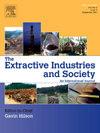Drivers of changes and transition pathways of sand resource extraction in tabasco, Mexico
IF 4.3
2区 社会学
Q2 ENVIRONMENTAL STUDIES
Extractive Industries and Society-An International Journal
Pub Date : 2025-08-06
DOI:10.1016/j.exis.2025.101752
引用次数: 0
Abstract
Sand, gravel, and crushed rock (sand resources) are the most extracted solid materials globally, with demand projected to double by 2060. To understand the drivers of this changing demand and building on the concept of transitions in sand production, we studied the transition pathways—namely, intensification, separation, and substitution of sand resources in Tabasco, Mexico. We drew on regional official records, semi-structured interviews and field observations on two sand resources production hotspots: Cunduacán (river sand) and Macuspana (crushed rock). Our results reveal that sand extraction in Tabasco increased from annual average volumes of 3 Mt (2006–2010) to 61 Mt (2016–2020). We identified urban expansion and flood control efforts as the main drivers of change in the region, with more recent changes driven by large-scale infrastructure development projects. Cunduacán and Macuspana accounted for 78 % of authorized extraction, driven by technological and machinery-related changes that enabled production intensification and diversification. Given the strategic location and infrastructure connectivity of these hotspots, they have become key sources of supply for local demand but also for peripheral municipalities with high material needs and limited productive capacity. Although extraction volumes from quarries began to exceed those from rivers in 2015, interviews and fieldwork revealed no evidence of substitution that would indicate a transition from river mining to crushed rock production. Studying transition pathways is a crucial first step towards understanding the implications of increased sand resources consumption and can support regional development with broader environmental and social sustainability goals.
墨西哥塔巴斯科沙资源开采变化驱动因素及过渡途径
沙子、砾石和碎石(砂资源)是全球开采最多的固体材料,预计到2060年需求将翻一番。为了了解这种需求变化的驱动因素,并建立在产砂过渡概念的基础上,我们研究了墨西哥Tabasco砂资源的过渡途径,即集约化、分离和替代。我们利用了区域官方记录、半结构化访谈和对两个砂资源生产热点:Cunduacán(河砂)和Macuspana(碎石)的实地观察。研究结果显示,塔巴斯科的采砂量从2006-2010年的年均300万吨增加到2016-2020年的6100万吨。我们认为城市扩张和防洪工作是该地区变化的主要驱动因素,最近的变化是由大型基础设施开发项目推动的。Cunduacán和Macuspana占授权开采量的78%,这是由于技术和机械相关的变化使生产集约化和多样化。鉴于这些热点地区的战略位置和基础设施的连通性,它们已成为当地需求的主要供应来源,同时也成为物质需求高、生产能力有限的周边城市的主要供应来源。尽管从2015年开始,采石场的采掘量开始超过河流采掘量,但采访和实地调查显示,没有证据表明从河流采掘向碎石生产过渡。研究过渡途径是了解沙子资源消耗增加的影响的关键的第一步,可以支持具有更广泛的环境和社会可持续性目标的区域发展。
本文章由计算机程序翻译,如有差异,请以英文原文为准。
求助全文
约1分钟内获得全文
求助全文
来源期刊

Extractive Industries and Society-An International Journal
ENVIRONMENTAL STUDIES-
CiteScore
6.60
自引率
19.40%
发文量
135
 求助内容:
求助内容: 应助结果提醒方式:
应助结果提醒方式:


